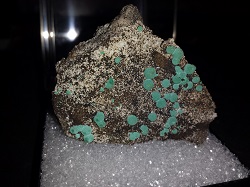A- |
B- |
C- |
D- |
E- |
F- |
G- |
H- |
I- |
J- |
K- |
L- |
M- |
N- |
O- |
P- |
Q- |
R- |
S- |
T- |
U- |
V- |
W- |
X- |
Y- |
Z |
AURICHALCITE:Aurichalcite forms in the oxidation zones of zinc-copper deposits. Crystals are acicular or fibrous and found in tufted aggregates. The color is an attractive grass green to pale green. Aurichalcite will at times partially cover red limonite and be associated with such colorful minerals as azurite,smithsonite and malachite. Specimens of aurichalcite certainly make for colorful "landscape" specimens.Aurichalcite can be confused with Rosasite, (Cu, Zn)2CO3(OH)2. However rosasite is usually more massive but not lamellar. Rosasite crystals are harder than aurichalcite; 4 vs 1 - 2, respectively.
Luster is silky to fibrous or pearly on more massive specimens.
Transparency crystals are transparent to translucent.
Crystal System is orthorhombic; 2 2 2
Crystal Habits include radiating tufts of acicular crystals. also encrustations of fiberous or lamellar masses.
Hardness is 1 - 2
Specific Gravity is 3.6 - 4 (above average for non-metallic minerals)
Cleavage is perfect in one direction.
Fracture is uneven or fiberous.
Streak is white to pale shades that depend on color.
Associated Minerals include limonite, smithsonite, azurite, malachite, rosasite and calcite.
Other Characteristics: effervesceses easily in cold dilute hydrochloric acid.
Notable Occurrences include Bisbee, Arizona; Laurium, Greece; Tsumeb, Namibia and Mapimi, Durango, Mexico.
Best Field Indicators are crystal habits, color, associations, softness and reaction to acid.
|

